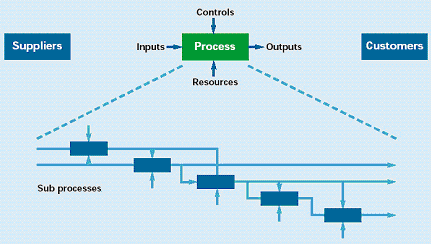mapping process
One of the initial steps to understand or improve a process is Process Mapping. By gathering information we
can construct a "dynamic" model - a picture of the activities that take place in a process. Process maps
are useful communication tools that help improvement teams understand the process and identify opportunities
for improvement.
ICOR (inputs, outputs, controls and resources) is an internationally accepted process analysis
methodology for process mapping. It allows processes to be broken down into simple, manageable and more
easily understandable units. The maps define the inputs, outputs, controls and resources for both the high
level process and the sub-processes.

Process mapping provides a common framework, discipline and language, allowing a systematic way of working.
Complex interactions can be represented in a logical, highly visible and objective way. It defines where
issues or "pinch points" exist and provides improvement teams with a common decision making framework.
To construct a process map:
- Brainstorm all activities that routinely occur within the scope of the process
- Group the activities into 4-6 key sub-processes
- Identify the sequence of events and links between the sub-processes
- Define as a high level process map and sub-process maps using ICOR
Process maps provide a dynamic view of how an organisation can deliver enhanced business value.
"What if" scenarios can be quickly developed by comparing maps of the process "As is" with the process "To be".
|

